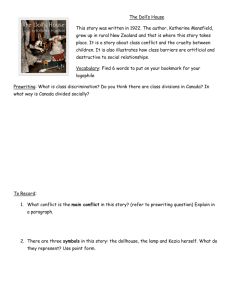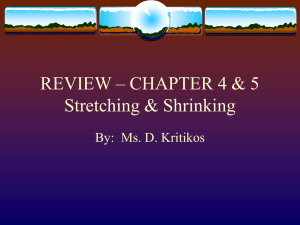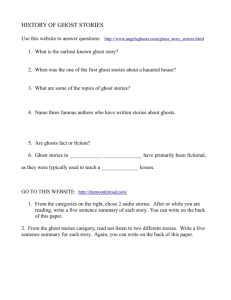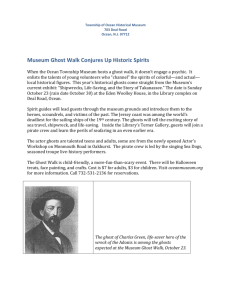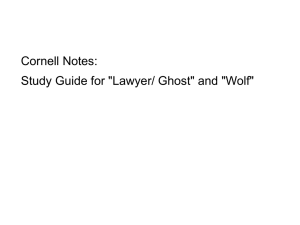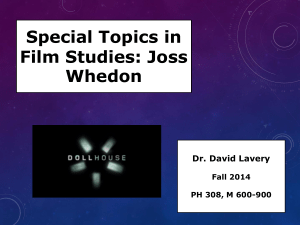Betty Ren Wright
advertisement
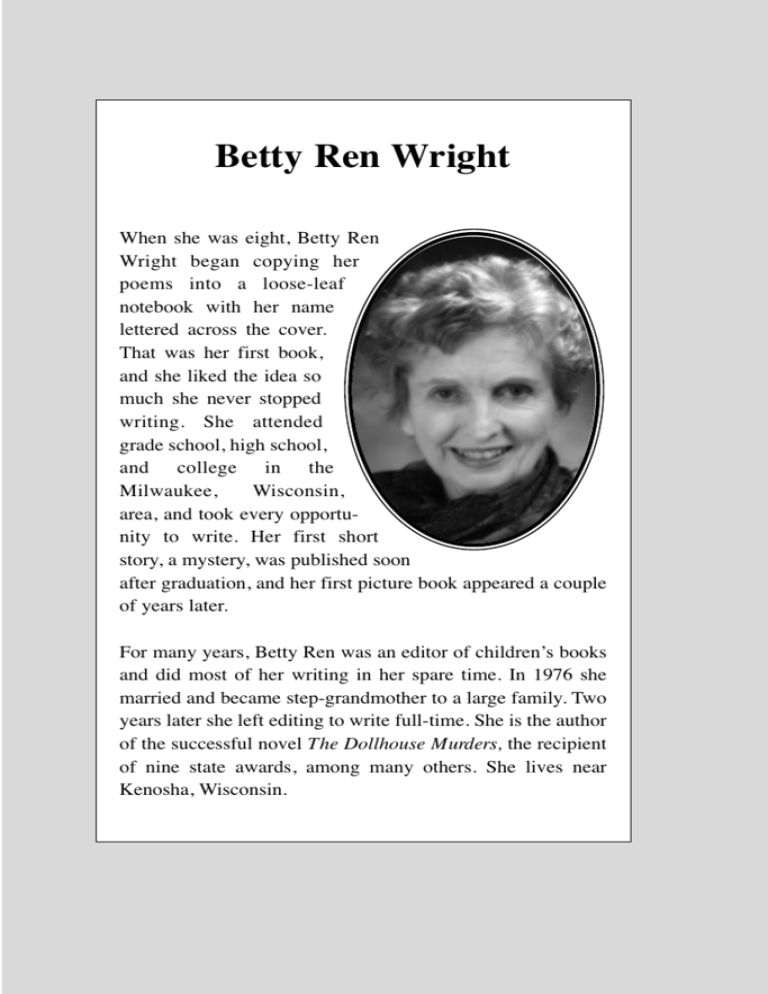
Betty Ren Wright When she was eight, Betty Ren Wright began copying her poems into a loose-leaf notebook with her name lettered across the cover. That was her first book, and she liked the idea so much she never stopped writing. She attended grade school, high school, and college in the Milwaukee, Wisconsin, area, and took every opportunity to write. Her first short story, a mystery, was published soon after graduation, and her first picture book appeared a couple of years later. For many years, Betty Ren was an editor of children’s books and did most of her writing in her spare time. In 1976 she married and became step-grandmother to a large family. Two years later she left editing to write full-time. She is the author of the successful novel The Dollhouse Murders, the recipient of nine state awards, among many others. She lives near Kenosha, Wisconsin. Exclusive Author Interview with . . . BETTY REN WRIGHT What types of books did you like to read when you were a child? I read constantly, and pretty indiscriminately; my mother brought home armfuls of books from the Teachers College library every Friday, and I swallowed them whole. I loved family stories, animal stories (no matter how sentimental!). I did not care for fantasy; I craved ghost stories, but I wanted the ghosts to appear to ordinary people like me. That’s why you write ghost stories! I’ve always loved ghost stories; but when I was growing up, there always had to be an explanation for what appeared supernatural. I wanted real ghosts, and starting with The Dollhouse Murders, I found them. I’m so glad there were lots of readers who wanted the same thing. Where do the ideas for your books come from? Well, like most writers I use my own experiences and the experiences of friends as starting points. Or I remember feelings I had in childhood and start there. Each time, the finished story is very different from what actually happened, because as I start writing I constantly ask myself, ‘What if . . .? What if that dollhouse were haunted? What if I were ten years old and had to spend the whole summer with a bachelor uncle who didn’t like children? What if my dreams actually came true, and I was afraid to tell my family what was happening?’ I consider lots of different what-ifs for each book; and by the time I’ve chosen my favorites, the book has begun to take shape. Tell us about two of your most popular books, The Dollhouse Murders and Christina’s Ghost. The Dollhouse Murders really began the day I watched two young brothers, one of them mentally challenged, sharing a picnic at a roadside stop. The direction of the novel was settled the day I helped my friend “clean” her dollhouse (we used very delicate watercolor brushes). What fun writing this book was! A friend had built a glorious dollhouse that was an exact reproduction of her grandparents’ home. Paintings, books, bedclothes, furniture—it was perfect! What it needed, I decided, was some ghosts. I was interested in family problems that result when a child has intellectual disabilities—I had written magazine fiction and a third-grade reader around that subject—and I’d wanted to use it again in a book-length story. The characters and the setting went together so easily, the book almost wrote itself. The setting for Christina’s Ghost grew out of the many hours I spent as a child at an isolated lake cottage. When I was a little girl, my mother periodically decided I should experience “family life”; and off I went to stay with an aunt, uncle, and four teenage cousins. I never forgot the feelings of total dislocation that went with those visits—my aunt was accustomed to four teenage boys, and the boys barely noticed the visitor curled up in the library with a book. I wanted to reproduce some of the lost feeling in Christina’s summer with Uncle Ralph, but I wanted Christina to be as unlike me as possible. She acknowledged her discomfort, but unlike me she set out to do something about it. She became the girl I wished I had been. Amy in The Dollhouse Murders sure is a spunky heroine! Amy is a protagonist who grew stronger under pressure—a trait I certainly admire. (If I were Amy, I probably wouldn’t have run away in the first place!) Do you have a favorite spooky, old house that you visited or ever stayed in? For a dozen years or so I lived in an apartment created from the sunroom of a huge hundred-year-old house in Racine. It was sometimes drafty but always sunny, and it had a fine working fireplace. I loved every minute of my time there, even after the owners, who lived in the rest of the house, told me it was haunted. Unfortunately the ghost or ghosts never visited the sunroom. What were your favorite books growing up? I like the old-fashioned stories (old-fashioned even when I was a child) such as Little Women, Little Men, Treasure Island, and Black Beauty. In my grandparents’ little library I discovered a treasure trove of Horatio Alger (my uncle’s), and I read some Nancy Drew, though she wasn’t a great favorite. Later, Precious Bane by Mary Webb became my “best book ever”—a kind of real-life fairy tale. What have you learned about yourself through your writing? Writing for young people has made me look back and examine my childhood and the influences that formed me. I guess I’ve learned to look back without blinking. What advice do you have for young writers? I have one answer: Read, read, READ! Read both fiction and nonfiction. That’s probably the most important! Make use of every opportunity to write, even if it’s an assignment that doesn’t particularly interest you. Read the works of many writers and ask yourself which you like the best and why. Try to decide what your favorite authors have done to make their books interesting. You’ll develop taste and judgment that will help you to do your best work when you sit down to write.
